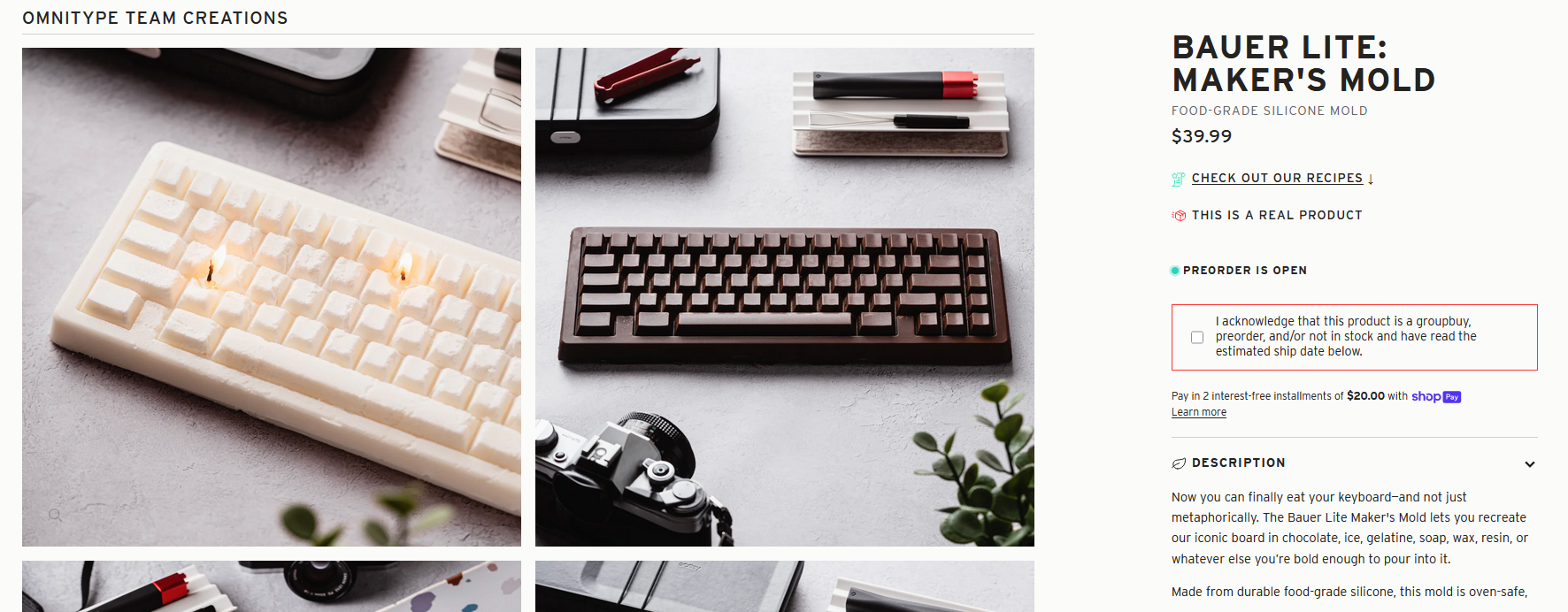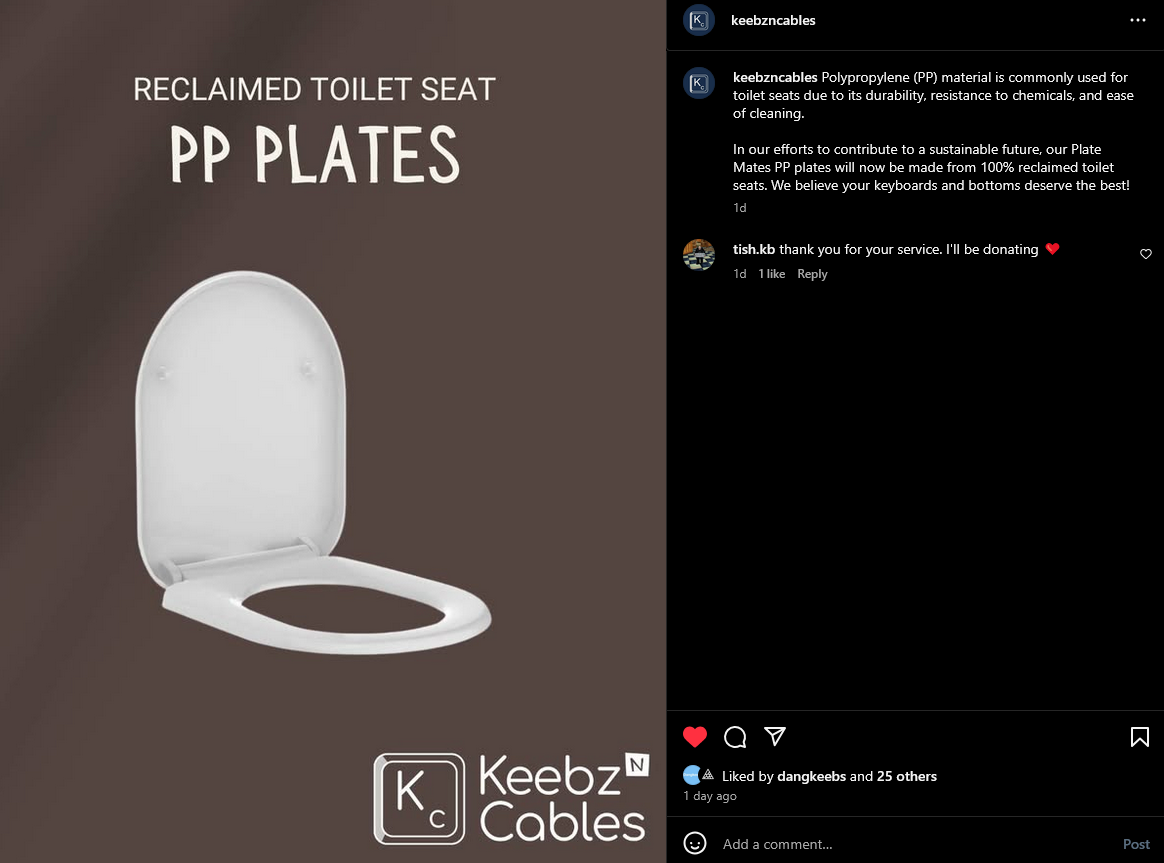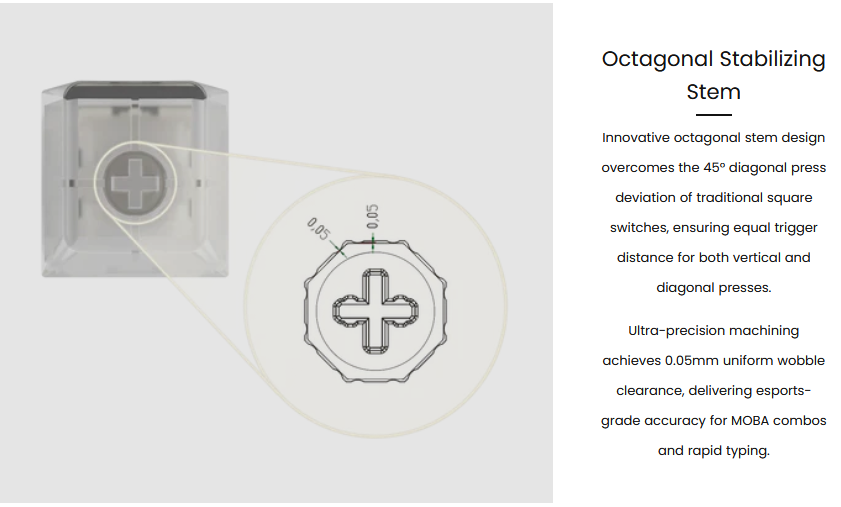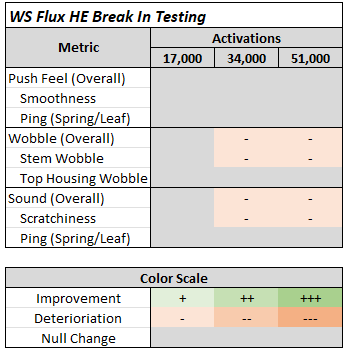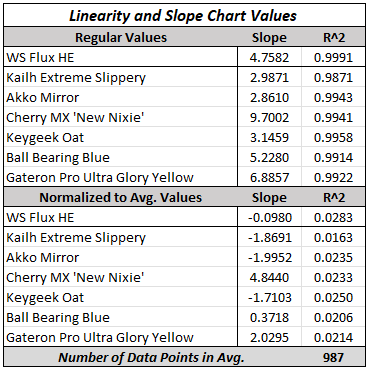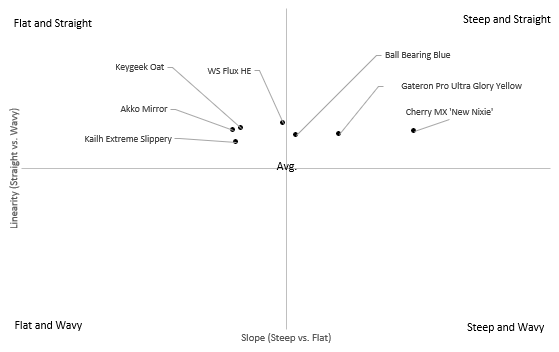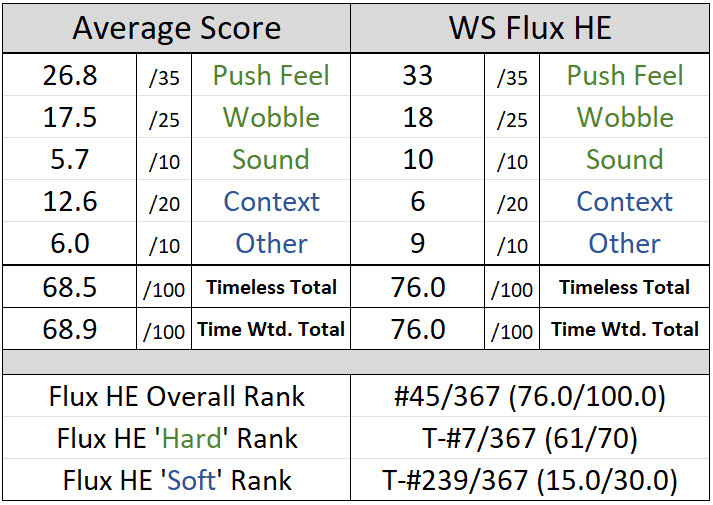WS Flux HE Switch Review
This month is entirely out of order from front to back and I plan to see it all the way through to the end of its chaotic, perpetual tumble. In my rush to cram together the Cherry MX Northern Light Switch Review while simultaneously preparing for a wedding, and of coursing adding meta level commentaries on both of those to the top of that review, I completely forgot to go over my favorite bits from this year’s keyboard-related April Fools jokes. Since it’s still barely April, I figured it would be better late than never. For those of you who have absolutely no idea what I’m talking about here, I’m not the only person in the community at large that takes part in making a facetious keyboard-related post on April Fools Day. In fact, it’s been traditional for content creators, keyboard and keycap designers, and even vendors alike to participate in April Fools over the years and it was because of some of these early posts all those years ago that I was inspired to take part in it myself when I started this website. While I of course think that the effort I put into this year’s Leviton Decora Edge White Switch Review was one of the more extensive April Fools jokes that I saw, and it did even result in Leviton’s marketing team sending me a free Decora Edge Dimmer switch for the collection after giving them a good laugh, there’s definitely quite a few that deserve some solid kudos sent their way. Omnitype especially knocked it out of the park this year with their Maker’s Series Bauer Lite “keyboard”. I really did believe at first that they were selling mini Bauer chocolates, candles, and ice, and so my surprise in realizing that these were actually real, full sized pieces made out of a food grade silicone mold was honestly beyond surprising. As well, Novelkeys also deserves some due credit for their ‘Any Key’ keycap set that was just not a very funny meme render, but also a fully-fledged, mass produced keycap set that anyone could buy at a not too unreasonable price. Any design or funny idea that takes these keyboard memes and inside jokes and pushes them to the point of real, tangible products are always April Fools winners in my book. In addition to those first two honorable mentions, here’s some of the sights of some of my other favorite April Fools jokes I saw from over the course of the day:
Figure 1: Candle Wax and Chocolate keyboards made with Omnitype's Bauer Lite: Maker's Mold April Fools Day product.
Figure 2: GMK 'Any Keys' with matching 'Panic Key' ESC accent.
Figure 3: Drop's Egg Yolk Keycap set with matching, well timed reference about the current state of the US economy.
Figure 4: Keebz N Cables taking sustainability one step further with reclaiming toilet seats for future keyboard plates.
Figure 5: Sleebys, or the infinitely more safe for work version of CYSM's actual April Fools Day caps...
Figure 6: Leviton's marketing team did honestly deliver with a free Rocker Dimmer Lever Edge switch as a thank you for the fun April Fools Day switch review.
Despite this month being full of jokes from the outset with April Fools all the way to the days that I’m working on this myself, I do want to stress that my announcement from the beginning of the month of having two awesome and interesting switch reviews to do this month on the 17th and 27th was anything but a joke. If you though the Cherry MX Northern Light Switch Review had some out-of-left-field surprises for you, then the rest of this Wuque Studio Flux HE review is definitely going to surprise you…
Switch Background
In full transparency, this review – like quite a few others over the past couple of years – has effectively come about as a result of people related to the development and/or selling of these switches approaching me to see if I would be interested in reviewing them. My policy on that has always been pretty simple and applied fully and evenly to everyone, even if they are a sponsor or good friend of the website – I have never and will never agree to do a review in exchange for switches. People are always welcome to send switches to me for internal testing or prototyping, some measurements here or there, or just out of the kindness of their hearts, but I will only ever write full length reviews for switches that I am actually interested in reviewing. After all, someone has to actually suffer through the full length of these things. Admittedly, though, this “only if I want to” sort of policy does lead to a bit of a grey area that arises when people reach out to ask if I am interested in reviewing some switches of theirs and I actually really want to review them. In that rare and fleeting case, I will certainly take the switches but also reiterate to them at least once that I can not and will not promise a review of them nor will I give them any input, feedback, or heads up should I choose to do said review. After all, it saves me a few bucks to just take the switches for free when I would otherwise have to pay to review them! (And in case you’re wondering, yes, this has caused some vendors to stop talking to me altogether as they had thought that I was just saying things like this for posterity and didn’t actually mean them.) The reason that I am going through the entirety of this tangent is because the WS Flux HE switches were ones among that rare grey area set of switches that really did strike me in the “Damn, I really do want to review these” feelings even in spite of them not having been released, announced, or even marketed by the time that I was reached out to. Renders of parts, internal design documents, marketing brochures, and a whole lot of information very quickly passed through my inbox after having asked them just a few questions and I knew that I absolutely had to get a set in the mail for me to get my hands on. Despite having very little historical context as they were only released a handful of weeks ago, the WS Flux HE switches already had a whole lot of background to them in their infancy.
“Hey there, we have a new switch that might interest you” is beyond a doubt one of the worst ways to try and get my interest hooked on a switch via a cold DM on Discord. I think it literally took something like 18 hours before I decided to respond to them initially. After having asked for a little bit more information, I was greeted with the response that “Wuque Studio has worked to create a new Octagon Hall Effect Switch.” What the hell is an octagon switch? Next thing I know, I was presented with at least a dozen pictures of part renders, measurements, and CAD drawings (which I’m unfortunately not allowed to share) that showed to me for the first time switches that had all of the following:
- Octagonal prism shaped stems that push through octagonal holes cut into the top housings.
- ‘T-Shaped’ slider rails that look quite similar to those that I first remember encountering in my Gateron Dual Rail Magnetic Orange Switch Review.
- Entirely new molds for literally all the components, including new springs and LED diffusers to go among the new housings and stems as well.
- A new, proprietary “precision factory lubing” technique that uses a newly developed precision lube application device. (It should also be mentioned that the design of such certainly did look realistic and feasible to me as an engineer as well…)
- Oh, and these switches are Hall Effect too for good measure.
I mean what was I supposed to do? Should I have not reviewed these switches? I’ve seen so many brands and vendors come out with ‘NeW SwiTch DeSigNs’ over the years that the phrasing has more or less come to implicitly mean “small revisions” at best in my mind. It’s been quite a hot minute since I’ve seen a switch that was truly designed from the ground up with entirely new molds, technology, and with a fresh design aesthetic in mind. In fact it had been so long that I then started to wonder as to who was actually making these switches. The photos I had had no clear mold markings, no similarities to designs I know that other manufacturers are working on, and there wasn’t any marketing claims made as to who made these switches anywhere that I could find. Turns out the answer to that was even more surprising than the lengthy answers I got about the switches themselves.
Figure 7: WS Flux HE marketing render from Wuque Studio's sale page discussing the benefits of an octagonal stem design.
Figure 8: WS Flux HE marketing render from Wuque Studio's sale page discussing the benefits of the 'T-Slide' rail design for their stems.
After having asked the person who had initially reached out to me about the Flux HE switches where in the world they actually came from, I was met with a pretty simple and direct answer of “A new company by the name of K2”. After having probed a bit about this answer, as a result of my years of experience and dozens of different instances in which random resellers or brands have claimed that they “make their own switches”, they added the sparse detail that the new factory was supposedly started by someone who had had about 20 years of experience in switch manufacturing elsewhere. (I’ve also heard it rumored elsewhere that this is something closer to 15 years, with some of them being at Gateron of all places.) Armed with this very hard to Google name and knowledge of the singular switch they’ve produced and not yet marketed, I went to digging around online and as expected found absolutely nothing. I personally could not find a trace of the existence of a K2 switch manufacturer anywhere online. Trying to squeeze literally any more detail out of my contact, I was told that the Wuque Studio team would be visiting the factory in the coming days and that they would definitely be taking some photos for me as a sanity check and ‘proof of life’ validation. And take some photos they certainly did. Below, you’ll find over a dozen different photos from within K2 taken by the WS team showing off all of the company’s capabilities, some of their manufacturing machines, and one very subtly hidden piece of branding. Unfortunately the picture of the front of the building with their full and proper name on it I was asked not to share. Armed with all of these photos, I do still hold a tiny bit of doubt in my mind as there have been some other “new manufacturers” that have popped up and gone with hardly any switch releases (I’m looking at you Momoka and Meirun), though the photos certainly do look compelling and point the very real and tangible existence of yet another switch manufacturer. So on top of all of the interesting new design facets and bells and whistles, toss all this information onto the pile and again judge me for choosing to take these switches for free. These have all the makings of the start of something incredibly interesting.
First debuted at the very end of March, 2025 by way of Wuque Studio’s various social media platforms, the Wuque Studio Flux HE switches, which are shortened in name frequently as ‘WS Flux HE’, were pitched as a Wuque Studio and K2 collaboration to allow users a seamless transition from mechanical into Hall Effect switches. Boasting all of these design features to supposedly improve upon the shortcomings of presently available and still fairly new Hall Effect style keyboard switches, the stem designs, ‘T-Rail’ system, and precision lubing were all stated as being included to improve the consistency, tolerances, and overall feeling of the switches. Coming in full polycarbonate housings and with a semi-light bottom out force of around 50 gf, the WS Flux HE switches were being sold on Wuque Studio for $20 per pack of 10, or $2 per switch, as of the time of writing this review. While certainly significantly steeper in price than most other Hall Effect switches presently available on the market today, I’d imagine this is largely due to the increased costs from prototyping and mold developed incurred in the making of the Flux HE switches. As well, I’d imagine this design effort and elevated cost will lead to these switches being around for purchase for many, many months (if not years) into the future.
Flux HE Performance
Note: For the rest of this review I am paradoxically holding ‘K2’ as the very real and tangible maker of the WS Flux HE switches and also as a completely unknown, unproven manufacturer. As time has gone on over the years, I’ve wanted more and more proof of life of manufacturers before formally recognizing them in my documentation and as a result I’m waiting until later in the year for K2 to produce more switches and give more signs of life. As well, this allows me to do one combined “Manufacturer Update” short article at the end of each year like I did in 2024 and 2023.
Appearance
At the highest level, the WS Flux HE Switches come in a milky, translucent yellowish-white over cream yellow color scheme that is absolutely in no way, shape, nor form connected to their name or some overarching nominal theme. In fact, I think this is the first switch that I’ve encountered in quite some time whose name is so wholly disconnected from it’s overall color scheme. I suppose it is at least thematically accurate still to be called “Flux” for being a Hall Effect switch, though. While a glance from across the room and without your glasses may lead you to believe that this isn’t even a keyboard switch at all, any sort of sight correction make these out as not just keyboard switches but abundantly and readily unique from other keyboard switch offerings. Whether it’s the massive ring on the underside of the bottom housings where the stem magnets ostensibly collide or the eight sided stems and holes in their top housings, there really are no switches out there currently that look like the WS Flux HE switches. There’s so many interesting niche details, design quirks, and adjectively loaded features of these switches that it’s hardly worth going over at any larger detail than a part by part level. All explorations of the details that make the WS Flux HE switches unique are discussed in the paragraphs and photos below.
Figure 10: WS Flux HE switches and their components.
The milky yellowish-white, polycarbonate top housings of the WS Flux HE switches are by the far the most subtle of the components of these switches when it comes to their impactful design details. Outwardly, these housings really just seem like milky, winglatch style tops with some weirdly sized stem and LED diffuser holes cut into them, but closer inspection proves this to be anything but the case. In addition to the stem hole in the top housings being octagonal to handle the similarly shaped barrel of the Flux HE stems, it also has slight guider nubs on each of the faces – something which is seen on the north and south edges of the stem holes in traditional MX style switch designs. As for the LED diffuser hole, it is relatively thick and rectangular and is cut in such fashion to accommodate the truncated, triangular wedge shaped light diffusers that are unlike any design I’ve seen in other switches elsewhere. A final note for the outside of the WS Flux HE switches also includes that these switches are in fact branded despite their lack of branding in the marketing material I saw before, featuring a large, subtly embossed ‘W’ logo for Wuque Studios on top side of the switch housing opposite of the LED diffuser. Internally, the housings get even more interesting as they are not only quite spacious but also carry the female guider rails that accompany the ‘T-shaped’ stem slider rails as shown below. While there have been a couple of switches over the years which have incorporated slider rails in their top housings rather than their bottom housings, this is still an exceedingly rare sight and one that is definitely a first for this interlocking stem and guider rail style design. In between all of these features, it is worth mentioning that I could not readily find any mold markings or numbers/letters which could help identify the origin of these parts and/or draw future connections to other seemingly K2-made switches.
Figure 11: WS Flux HE top housing external design showing slotted, wedge shaped LED, octagonal stem hole, and winglatch style attachment clips.
Figure 12: WS Flux HE top housing external top edge showing Wuque Studio logo branding.
Figure 13: WS Flux HE top housing internal design showing wide open cavity and the partially enclosed guider rails that the T-style stem slider rails slot into.
The similarly white colored POM stems of the WS Flux HE switches pack in a ton of features that are not nearly as subtle as these switches’ top housings, though are still just as interesting to see in practice. Perhaps the most “subtle” thing about the WS Flux HE stems is that of their incredibly short ‘T-Style’ slider rails. Whereas most conventional slider rails in MX switches stretch to around the 5.00 mm mark in length, and even shortened ones from manufacturers like KTT stretch well into the 3.00 mm+ mark, the slider rails on the WS Flux HE switches are just barely 1.80 mm in length. As well, the T-shaped rails are supported in all four corners by slightly squared off plastic sliders that don’t appear to do much of anything except highlight the fact that these stems are actually symmetrical about their E/W axis. Being Hall Effect switches that rely on a general magnetic field and not a directional point of actuation, these are among the only switch stems I know of that can reasonably be rotated within their housings without losing function. (Note that I did choose to emphasize reasonably for those crazy individuals among you that are now going to try that in MX style switches.) The dustproof walling around the stems of the WS Flux HE switch stems are in fact octagonal in shape but otherwise are unremarkable save for their layout, featuring smooth walls from top to bottom on all facets. The last truly interesting detail of the WS Flux HE stems is that of the ‘fanning’ that exists on the underside of the upper part of the stem. Looking a bit more like mushroom gills than any other reasonable analogy I can come up with, I’m not entirely certain that these serve any purpose at all but they sure look fancy while doing it. I’m a bit curious how much of the apparent but subtly applied factory lubing on the stems ends up in these gills over time.
Figure 14: Right side up view of the WS Flux HE stems showing octagonal dustproof walls, T-shaped slider rails, and a thick center pole that houses the strong HE magnet.
Figure 15: Upside down view of the WS Flux HE stems showing the mushroom gill-like ribbing on the underside of the stem.
Finally arriving to the cream yellow polycarbonate housings of the WS Flux HE switches, these too feature quite a few details that I’m not entirely sure provide much of anything in the way of explicit switch performance. However, much like the octagonally shaped stem walls and the mushroom gills on the undersides of the stems, they sure do it in a fancy looking fashion. Internally, the bottom housings are symmetrical about their N/S axis and feature one large, octagonal shaped center stem pole hole to accommodate the magnets in the stems that is flanked on all sides by fancy dampening pads. Shaped in a starburst-like pattern, I imagine these pads serve to help dampen the bottoming out of the switches, or at the least to reinforce the “four point bottoming out” that is marketed for the Flux HE switches on Wuque Studio’s sales page. These housings would also be symmetrical about their E/W axis, as well, if not for the reinforcements located in the upper part of the housing of the opposite of the through-housing LED slot. (Note that these could be hollowed or drilled out through this region to make the housings even further symmetrical for those crazy individuals among you still reading this section.) Externally, the bottoms of the WS Flux HE switches are incredibly barren of detail and feature only two PCB mounting pins and a slightly shiny ring on the bottom side that ostensibly marks where the magnet is supposed to contact on the inside of the housings. Beyond these features, and four little stand out nubs in each corner of the bottom housing underside, I could also not find any identifying mold marks to be linked back to K2 at any point in the future.
Figure 16: WS Flux HE switch bottom housing interior showing starburst patterned dampening pads and then large, octagonal shaped center pole hole for the magnet to travel through.
Figure 17: WS Flux HE switch bottom housing exterior showing PCB mounting pins and large circular pad where the magnet of the stem assumedly bottoms out inside of the switch.
Push Feel
A decent amount of the marketing around the WS Flux HE switches and their more complicated design details revolves around fixing perceived weaknesses that HE switches currently on the market exhibit. After having tried these switches out in hand, for the life of me I can’t exactly figure out what these issues are that they are trying to correct for – not because these switches are overly flawed or not good in their own right, but rather because they are so well balanced and clean in their execution instead of clearly overcompensating for one thing in particular. If it was smoothness that was the perceived weakness, I would have imagined that these switches would be overlubed. Instead, they’re actually incredibly consistently and evenly lubed and feel perfectly smooth, with no scratch, and with not an ounce of gumminess or spottiness in their application. The Flux HE switches are a perfect example of one of those rare linears that are perfectly smooth but with such a perfect touch of factory lubing that they hardly are recognizable as being lubed. They just feel smooth. If thinness or weird feelings at the point of bottom out were the perceived problem that was being fixed, the Flux HE switches have a bottom out that fits right in with their overall vibe and instead of sticking out as overly loud or overly dampened. Sure it is noticeably a bit more in-your-face than something like bottoming out onto a thick, heavy feeling Cherry nylon housing, but the bottom outs of the Flux HE switches are hefty, flat, and punch with a balanced and not overly aggressive edge. The topping outs of the Flux HE switches are a bit thin by comparison, though honestly this is just assumed to be due to mechanical differences in the housings rather than differences in material or poor design choices. Hell, even the force curves for these switches both feel true to their actual in hand value and effectively match the marketing that exists for these switches out there. I’m genuinely struggling to find many, if really any faults with these switches in terms of their push feeling and because they so finely strike that balance in all of these areas, it’s hard to imagine what they were trying to correct for in the first place.
Figure 18: Force curve diagram for the stock WS Flux HE switch.
Sound
The WS Flux HE switches are, on the whole, decently loud linear switches that have sound profiles entirely driven by their bottom outs as you could probably have guessed based on the notes in the ‘Push Feeling’ section above. Despite being loud, though, the bottom outs of the Flux HE switches are flat, medium to high in pitch, and have incredibly well rounded and balanced tones. They’re not sharp and pointy, nor are they dull and muted – it’s a pretty squarely plastic-on-plastic sound that isn’t offensive, definitely is noticeable, and doesn’t stray too far into the ‘bad’ parts of any one particular type of bottoming out sound. By comparison the topping outs of the Flux HE switches are a bit more dulled and quiet, but even these are definitely well rounded in their overall tone as well. As for the consistency of the sound of these switches, I’m incredibly impressed with how identical these switches sound to one another not only at different typing speeds but also across the batch that of switches I received. I could not, for the life of me, find any differences in the tones of switches no matter what I did to try. Mind you this statement is not about trying to seek out the presence of scratch, ping, or any sort of other negative sound in a switch either as there absolutely is none – this consistency is just with respect to their overall tone and pitch. (Don’t even pretend to think for a second that I heard differences in factory lubing either – that is also non-existent.) I can’t recall the last time I came across switches that were just this consistent in terms of their sound profiles, good, bad, or otherwise.
Wobble
Despite all of the marketing material for these switches talking about improved tolerances and new molds, the stem wobble of the WS Flux HE switches is still just painfully a touch above average. Equal in magnitude in the N/S and E/W directions, it’s certainly not likely to bother most users except those that are super picky about stem wobble, but I’d be lying if I didn’t think that the stem wobble could just be a bit better. At the extreme least I was expecting these to have less stem wobble purely due to the sheer number of features in their design which seem to have been geared towards fixing this issue.
Measurements
Figure 19: Numerical details regarding the stock WS Flux HE switches.
Have you ever wanted to be bombarded with more switch data than you’ve ever seen at any point in your life before? Consider checking out the ‘Force Curve Repository’ hosted on my GitHub that contains all force curves that I take both within and outside of these full-length reviews. In addition to having these graphs above, I have various other versions of the graphs, raw data, and my processed data all available for over 1000 different switches for you to use however you see fit. Check it out via the ‘Archive’ tab at the top of this page or by clicking any of the force curve cards above.
Break In
Break In Notes
17,000 Actuations
- After 17,000 actuations, the WS Flux HE switches did not change in any meaningful way compared to their stock form. I was completely unable to distinguish broken in switches from stock switches when blindly trying them out here.
34,000 Actuations
- After 34,000 actuations, some changes did begin to show up in the WS Flux HE switches, though they were all incredibly subtle and hard to detect. Chief among these changes was that of the appearance of a slight scratchy feeling that I imagine came about as a result of factory lube migration.
- Additionally, there was a slight increase in the N/S and E/W direction stem wobble of the WS Flux HE switches broken in this far.
51,000 Actuations
- Surprisingly, the WS Flux HE switches seem to have effectively stopped their changes from break in at 34,000 actuations. There is virtually no difference in the performance of these switches broken in to 51,000 actuations than their 34,000 actuation counterparts.
Figure 21: Comparative force curve diagram showing no substantial change in the force curves of the WS Flux HE switches throughout the break in process.
Comparison Notes to Other Notable Linear Switches
Note – These are not aimed at being comprehensive comparisons between all factors of these switches as this would simply be too long for this writeup. These are little notes of interest I generated when comparing these switches to the WS Flux HE switches side by side.
Figure 22: Switches for comparison. (L-R,Top-Bot: Kailh Extreme Slippery, Akko Mirror, Cherry MX New Nixie, Keygeek Oat, Ball Bearing Blue, and Gateron Pro Ultra Glory Yellow)
Kailh Extreme Slippery
- The Kailh Extreme Slippery switches have a minor bit more N/S and E/W direction stem wobble than the WS Flux HE switches, though not by much at all.
- In terms of their sound profiles, these two switches are similar in their overall volumes but different in their tonalities. The Extreme Slippery switches are sharper, more pointy, and have a more singular tone as compared to the vibrant, well rounded, and consistent bottom out tones of the WS Flux HE switches.
- Despite the Flux HE switches only having a total stroke length that is a few tenths of a millimeter longer than that of the Kailh Extreme Slippery switches, they definitely feel as if they bottom out much lower than that of the Slippery switches.
Akko Mirror
- While I’ve described both the Akko Mirror and WS Flux HE switches as having downstrokes that are effortlessly smooth and nearly perfectly lubricated, the Akko Mirror switches feel as if they just have the tiniest bit more resistance to their stroke than the WS Flux HE switches.
- These two switches are on the opposite end of the spectrum when it comes to their sound profiles, with the Mirror switches being more subtle, subdued, and nearly silent when directly compared to the louder, more in-your-face bottom outs of the WS Flux HE switches.
- The Akko Mirror switches have significantly less N/S and E/W direction stem wobble than the WS Flux HE switches, and that is even in spite of them not having a significant amount of R&D poured into new molds and increased tolerances for the Mirrors.
Cherry MX New Nixie
- Even in spite of the fact that the Cherry MX New Nixie switches are lubed using Cherry’s advanced MX2A switch platform, they are still quite a bit more scratchy than that of the WS Flux HE switches.
- The comparative force curve between these two switches below seems incredibly inaccurate, with both switches in hand feeling as if they bottom out at much more similar weights than what is depicted in the chart. I suspect some amount of this perceptual difference may be due to the comparatively more aggressive bottom outs of the WS Flux HE switches.
- Much like with the Akko Mirror comparison above, the New Nixie switches are significantly more subdued, quiet, and subtle than that of the WS Flux HE switches.
Keygeek Oat
- The Keygeek Oat switches have a fair bit less N/S and E/W direction stem wobble in them than the WS Flux HE switches. That being said, though, I imagine neither of these would be too likely to bother most mechanical keyboard enthusiasts.
- Despite both of these switches being easily classified as quite smooth linears on their own merits, the WS Flux HE switches are noticeably more consistent in their factory lubing and have a much more effortless and subtle feeling to their strokes than the Oat switches.
- The bottom out feeling of the Keygeek Oats, much like most of the other switches on this comparison list, are much more subtle, dampened, and softer than that of the WS Flux HE switches.
Ball Bearing Blue
- Of all of the switches on this comparison list, the Ball Bearing Blue switches are the only ones which have bottom outs that are sharper, more aggressive, and significantly more noticeable than the WS Flux HE switches in terms of both feeling and sound.
- K2 should take note of the manufacturing tolerances on the Ball Bearing Blue switches as they absolutely blow the WS Flux HE switches out of the water when it comes to stem wobble. The Flux HE switches do not even remotely come close to the Ball Bearing switches by any reasonable margin when it comes to stem wobble.
- Where K2 does have a leg up on the mysterious manufacturer of the Ball Bearing Blue switches, though, is in their factory lubing capabilities. The WS Flux HE switches are smoother and more consistently so than that of any of the Ball Bearing switches that I’ve tried so far.
Gateron Pro Ultra Glory Yellow
- The comparison of the Pro Ultra Glory Yellow and WS Flux HE switches to one another is particularly interesting as the sound profiles of these switches are entirely driven by opposite housing collisions from one another. While the WS Flux HE switches have a sound that is entirely driven by their bottom out, the Pro Ultra Glory Yellows are driven by their topping out with a more poppy, rounded, and inconsistent tone.
- Of all of the switches on this comparison list, these two are the most comparable to one another in terms of their stem wobble relative to all other switches that I’ve tried to date.
- Without much competition, the WS Flux HE switches are significantly smoother and more consistent in their feeling than that of the Gateron Pro Ultra Glory Yellow switches.
Linearity
Figure 29: Absolute and relative Linearity and Slope values for each switch in this comparison section.
Figure 30: Qualitative comparison of the normalized Slope and Linearity for each switch in this comparison section.
If you are just now seeing this section for the first time and are a bit confused as to what I am talking about when discussing ‘Slope’ and ‘Linearity’, I highly suggest checking out my article titled ‘On Differences in Linear Switches’ where I explain what this section is for and how it came to be! For a bit of a shorter answer, know that this is part of my ongoing attempt to better quantify and articulate differences between linear switches which have historically not been captured in discussions about them.
Scores and Statistics
Note – These scores are not necessarily completely indicative of the nuanced review above. If you’ve skipped straight to this section, I can only recommend that you at least glance at the other sections above in order to get a stronger idea of my opinion about these switches.
Push Feel
The WS Flux HE switches are medium linears that boast a whole slew of design features and a new, incredibly precise factory lube application methodology from a new manufacturer in K2 that purport to fix a whole lot of issues with HE linear switches… and I’ve got the be honest they kind of nailed it. Perfectly smooth with no scratch, no ping, no substantial issues, and bottom outs that are firm, flat, and consistent across the batch and different typing speeds as well. These switches are about as clean and well executed as linear switches can come.
Wobble
Despite the octagonal stem shape or freshly designed top housings, the WS Flux HE switches are still painfully a bit above average when it comes to their equal magnitude N/S and E/W direction stem wobble. This isn’t likely to bother most users unless they’re picky about wobble.
Sound
The absolute peak of the performance of the Flux HE switches is in their sound profiles. Clean, crisp, perfectly consistent, and driven by a slightly loud but well rounded, medium to high pitch bottom out that stays just as consistent as it’s push feeling across use cases. No ping, no scratch, no weird tones, no subtle shifts in anything. It’s all there with no frills and no baggage.
Context
In spite of all of the praises that I could easily sing for the WS Flux HE switches, they cost $2.00 per switch. Sure, this price is higher to offset mold and production costs for a brand new switch and this is not the first time we’ve seen this, but that is literally the most expensive switch to date and for one that is not mechanically unique like other expensive switches at that…
Other
Wuque Studio deserves a pretty solid amount of credit in their collaboration with K2 on the Flux HE switches for both starting from scratch and jumping out to an insanely well performing, consistent, and carefully designed switch design. These have me excited for the future of K2…
Statistics
If you are looking at this statistics section and wondering what the heck happened since the last review, consider checking out my short article titled ‘A Scorecard Time Change’. Moving forward, switches are now ranked in this statistics table using a “time weighted total” as opposed to their day-of scoring as discussed in that article. If you’d also like to learn about what ‘hard’ versus ‘soft’ ranks refer to specifically, I’d encourage you to head on over to my GitHub linked in the table above or at the links in the top right hand of this website to check out my database of scorecards as well as the ‘Composite Score Sheet’ which has a full listing of the rankings for each and every switch I’ve ranked thus far.
Final Conclusions
I’m going to speed run through my discussion of the objective, in-switch performance features of these switches to get to the one, very overwhelming detail about the Flux HE switches that overtakes every other thought that I have about these switches. On the surface and in depth, the WS Flux HE switches are technically excellent and the reimagined features on all parts of these switches have clearly led to a switch that is more consistent, more cleanly executed, and just all around more well-constructed than the vast majority of all switches out there, let alone HE style switches. The excellence of these design details are even further bolstered by the improved precision factory lubing setup that K2 apparently has. It clearly has shown itself here to lube more cleanly, precisely, and consistently than any of the lubing lines I’ve seen from any other factory to date and I sincerely hope that K2 gets around to implementing this into the traditional, MX compatible footprint some time in the near future. Sure, these switches are a bit lacking in that their improved factory tolerances and mold redevelopments clearly missed the mark when it comes to stem wobble, though they’re still average even in that fault. That’s a bit of a small feature to get oneself hung up on in such an otherwise stellar linear switch and I imagine most people won’t care about that in lieu of their overall smoothness and consistency in push feeling and in sound. Do you know what people will care about more with these switches though? The fact that they are $2 per switch. No, that price is not inflated by tariffs because I’m in the US either – that is quite literally what they are being sold for around the world.
I have so many thoughts about the decision by Wuque Studio to price the Flux HE switches at this price point that I truly can’t seem to coral them into any coherent train of thought that would make for a proper review ending. On one hand, I keep looking at that price tag and thinking of all of the other inventive switches with substantial R&D and mold costs related to their development and wondering why it’s just so damn high with only the Flux HEs. Zeal’s Clickiez are $1.50 each, AEBoards’ Raed HE and Naevy EC switches are $0.69 each, Ball Bearing and Diamond switches are $0.65 each, and even TTC’s Neptune and Venus switches are $0.65 each. What the hell is going on in a Hall Effect linear switch that makes it, at the minimum, $0.50 per switch more expensive than any of those aforementioned offerings? On a second hand, I’m trying to piece together who Wuque Studio thinks their market is for these switches. HE style switches have yet to permeate deeply into the custom, more enthusiast end of the community due to a lack of PCB-based adoption of the technology, meaning that the majority of people buying these magnetic boards still exist in the entry level end of the hobby. You know, that end where people balk at the idea that a keyboard costs more than $100. Are they expecting people who have this issue with price and are buying entry level, plastic case HE keyboards from companies like Wooting to pay more than twice the price of that board just for a set of switches? Seriously? On a third hand that I don’t even have, I just keep reiterating the phrase “What the fuck?” to myself over and over again. The WS Flux HE switches are technically incredible switches that have the potential to be the cutting edge of the HE linear switch market and could really push the enthusiast grade adoption of the technology with their performance, but not by any chance at that price point. Next to nobody is going to pay for these switches and it’s very likely that Wuque Studio will sit on the stock of them both infinitely longer than they could have imagined and maybe well past the point that K2 remains a discussion point for switch manufacturing. For all of the thought and planning that clearly went into the design, development, and execution of these switches, oh holy shit did they really miss the mark when it comes to the pricing and sales pitch of these switches and they’re resultingly now poised to be the masterclass in how to not sell perfectly marketable switches. The funniest thing to me in all of this is that I have this level of concern about the pricing of these switches, and I got them for free. It’s probably for the best that I did as I doubt I would have ever paid anywhere near this much to review them in the first place…
Sponsors/Affiliates
Mechbox UK
- A wonderful UK based operation which sells singles to switches that I’ve used above in my comparisons for collectors and the curious alike. Matt has gone out of his way to help me build out big parts of my collection, and buying something using this link supports him as well as my content!
KeebCats UK
- A switch peripheral company based out of the UK which sells everything switch adjacent you could ask for, they’ve been a huge help recently with my film and lube supply for personal builds, and they want to extend that help to you too. Use code ‘GOAT’ for 10% off your order when you check them out!
proto[Typist] Keyboards
- An all-things keyboard vendor based out of the UK, proto[Typist] is a regular stocker of everything from switches to the latest keyboard and keycap groupbuys. While I’ve bought things from the many times in the past, they also are a sponsor of my work and allow me to get some of the great switches I write about!
Divinikey
- Not only do they stock just about everything related to keyboards and switches, but they’re super friendly and ship out pretty quick too. Divinikey has been a huge help to me and my builds over the last year or two of doing reviews and they’ll definitely hook you up. Use code ‘GOAT’ for 5% off your order when you check them out!
ZealPC
- Do they really need any introduction? Zeal and crew kicked off the custom switch scene many years ago with their iconic Zealios switches and the story of switches today couldn’t be told without them. Use code ‘GOAT’ (or click the link above) for 5% off your order when you check them out!
MechMods UK
- A rising vendor based in the UK, Ryan and crew have been a pleasure to work with and have nearly everything you’d need to build your first or fourteenth keyboard. Go build your latest or greatest one right now with them by using code ‘GOAT’ at checkout for a 5% discount!
Dangkeebs
- A longtime supporter of the website and the collection, Dangkeebs has quite possibly the widest variety of switches of any vendor out there. Not only is their switch selection large, but it rotates and is constantly adding new stuff too. You’re going to need 5% off your order with my affiliate to save off the cost of all those switches!
SwitchOddities
- The brainchild of one my most adventurous proxies, SwitchOddities is a place where you can try out all the fancy, strange, and eastern-exclusive switches that I flex on my maildays with. Follow my affiliate code and use code ‘GOAT’ at checkout to save 5% on some of the most interesting switches you’ll ever try!
Cannonkeys
- Does anybody not know of Cannonkeys at this point? One of the largest vendors in North America with keyboards, switches, keycaps, and literally everything you could ever want for a keyboard always in stock and with an incredibly dedicated and loving crew. Follow my affiliate link above in their name to support both them and I when you buy yourself some switches!
Kinetic Labs
- One of the most well-rounded keyboard vendors out there, Christian and crew have been supporters of all my switch and switch-adjacent needs for some years now. I’m honored to have them as an affiliate and think you should check them out using my affiliate link above to support both them and I when you check out their awesome products!
Keebhut
- Want to try out some switch brands that fly under most vendor’s radars? Keebhut is always seeking out that next latest and greatest and has been super helpful in hooking me up with new brands over the past year. They are all about sharing that love as well, and want to give you 5% off your next order with them when you use code ‘GOAT’ at checkout!
Kailh
- No, you’re not mistaken – this is actually that Kailh that manufactures switches. As one of the longest running manufacturers in the hobby, they have a massive variety of switches available over on their website at any point in time. I’m lucky to be affiliated with them now, and so consider using my affiliate link above when ordering some Kailh switches to support me!
Keebz N Cables
- Australia and Oceania’s very own is now a part of the sponsor list here and I couldn’t be happier to add this long time supporter of the collection to it. They’ve always got an amazing selection of switches (and other keyboard parts) in stock and they want to share the love that they’ve shown me with you all too! Use code ‘thegoat’ for 5% off your first order when you visit!
